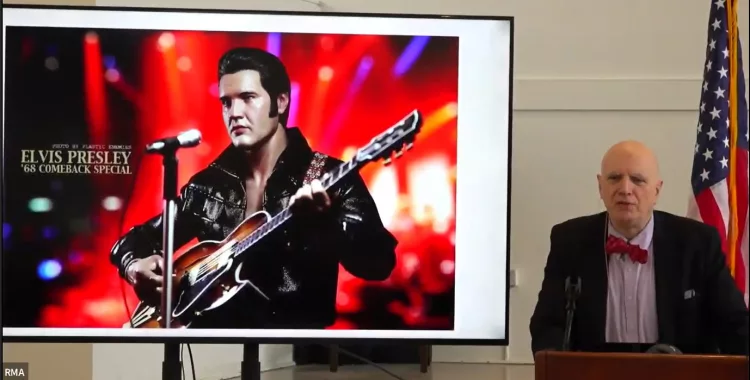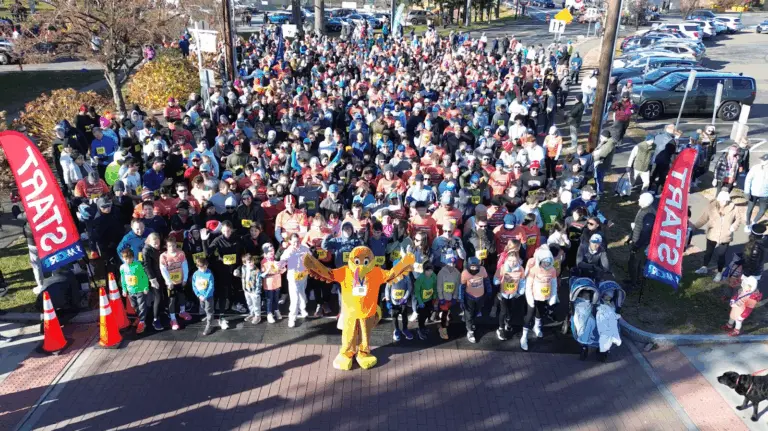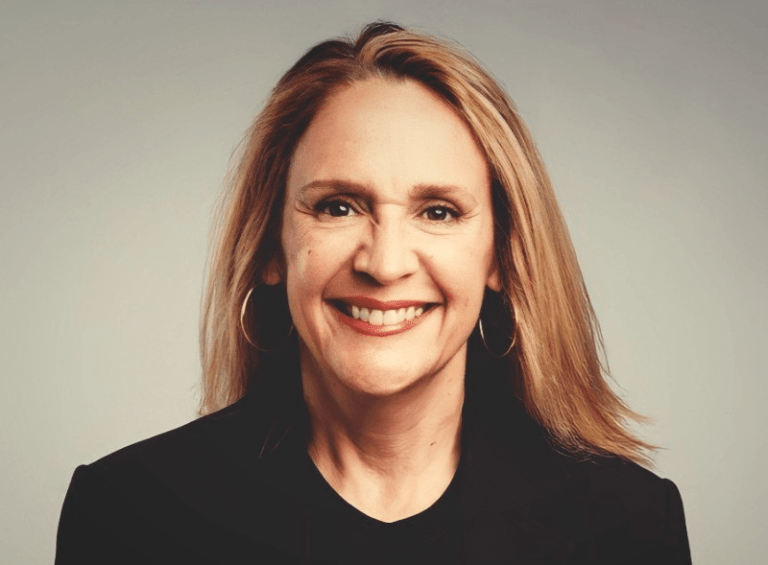
At the February 12th meeting of the Retired Men’s Association Tim Brooks introduced acclaimed author Will Friedwald, who presented “Elvis at 90: The Music of Elvis Presley.” Friedwald began by praising Brooks as a leading scholar of American music and the early recording industry, particularly highlighting Brooks’s book on early Black recording artists as a seminal work. The lecture then transitioned to Elvis Presley, framing his story in three acts and a prelude.
Prelude: 1935-1953
Act I – Breakthrough: 1954-1958
Act II – Hollywood: 1958-1967
Act III – Return of the King: 1968-1977
The prelude covered Elvis’s early years, while Act I described his rise to fame, from his first record in 1954 to his being drafted into the Army in 1958. This period is considered by some as Elvis’s golden age, a view the speaker respects but disagrees with. The second act encompassed Elvis’s Hollywood years, a period often criticized even by ardent fans. The final act starts with the 1968 Comeback Special, marking a return to form and a period of incredible momentum until the mid-1970s, after which Elvis’s decline began, culminating in his death in 1977 at age 42.
Prelude
Elvis was born January 8, 1935 in Tupelo, Mississippi to Vernon and Gladys Presley. The family’s struggles during the Depression were highlighted, with Vernon being at one point imprisoned for forging a check. This early hardship marked Elvis’s childhood. Later, the family moved to a housing project in Memphis in 1949, signaling an improvement in their financial situation. At this time, Elvis was already deeply immersed in music, buying records and studying various styles.
Despite his passion, no one seemed to encourage Elvis’s musical pursuits. Described as shy and retiring, Elvis possessed an inner confidence that propelled him forward. His favorite music was gospel, particularly quartets, a genre that experienced a boom during his youth. Elvis initially aspired to join a gospel quartet like the Blackwoods. Another influence was Captain Marvel Jr., a comic book character from whom Elvis supposedly drew inspiration for his haircut and later for his stage attire.
Breakthrough
In the summer of 1953 Elvis walked into Sun Records, a small local recording studio. The studio had two functions: recording anyone who wanted to make a record or a greeting, for a fee; and issuing a few records commercially. Elvis’s arrival was recounted through a dialogue involving Marion Keisker, the receptionist and owner Sam Phillips’s assistant. B.B. King’s quote about the young Elvis’s dynamic talent and unique approach to music, which he likened to that of Frank Sinatra, was also shared.
Sam Phillips recognized Elvis’s talent but struggled to define it. Elvis experimented with many genres, including R&B, Dean Martin, Frank Sinatra, Bing Crosby, gospel, country, and blues. He recorded a variety of songs for Sun Records, many of which have been released. His first record, “That’s All Right,” a reimagining of Arthur Crudup’s blues tune, was described as a transformative interpretation rather than a mere cover. Elvis’s first record became a local hit, largely due to DJ George Klein’s airplay on a Memphis radio station. The audience response was overwhelming, leading to Elvis being brought to the station for an on-air interview. This success led to a contract with the Louisiana Hayride, a radio show and concert tour that served as a farm club for the Grand Ole Opry. It was also during this time that he was heard by Colonel Tom Parker, an experienced promoter who became his manager.
Elvis’ popularity soared during the next few years. An indication of how popular he became was when RCA offered Sun Records $35,000 for his contract. That was the most ever offered for a recording artist contract at that time. Elvis signed with RCA in late 1955. In 1956 RCA had Elvis appear in his first movie, a bit part in which he sang “Love Me Tender.” The song became a huge success. During this time Elvis recorded numerous songs for RCA, often teen-oriented, like “Wear My Ring Around Your Neck” and “Teddy Bear.” Parker booked Elvis on several network television shows, including the Ed Sullivan Show, which received its largest audience share ever at the time. RCA tried to market Elvis as a rebel when in reality he was really deferential.
Hollywood
Elvis was drafted into the army in 1958, choosing to serve as an ordinary G.I. rather than a celebrity entertainer. Later that year his mother, to whom he was very close, passed away, which affected him deeply. While in the Army Elvis encountered three things that were to influence his life: martial arts, amphetamines, and Priscilla Beaulieu (born Priscilla Wagner), who he would later marry.
Once Elvis was out of the Army Colonel Parker initiated a bidding war for Elvis to appear on a TV show. At that time $12-15,000 was the standard payment. Elvis received $125,000 to appear on a Frank Sinatra special. It drew a huge audience.
Colonel Parker realized that the greatest amount of revenue with the least amount of work is in films. So he had Elvis concentrate on movies. Elvis starred in 30 films over a 12-year period. Many of them were cheaply made, and this phase of his career is widely recognized as his least creative.
Return of the King
During this final phase Elvis made two additional movies. His TV special “Elvis: Aloha from Hawaii” (1973) was broadcast worldwide and was the most watched TV special up to that time. Friedwald ended with “The American Trilogy” segment in which Elvis featured three songs, one of the Union, one of the Confederacy and one of African American culture. Through this performance Elvis tried to bring everyone together, being all inclusive.
A brief Question and Answer segment followed the presentation.
The talk can be viewed by going to the RMA website at https://greenwichrma.org, and clicking on “Speakers.”
The RMA’s upcoming presentation, “Breaking Glass: Tales from the Witch of Wall Street” by Patricia Chadwick, is scheduled for 11 AM on Wednesday, February 26, 2025. Please note that this and all future RMA presentations will be held at Christ Church Greenwich, Parish Hall, 254 E. Putnam Avenue, Greenwich, CT 06830.
Breaking Glass: Tales From the Witch of Wall Street is Patricia Walsh Chadwick’s second book, and is a sequel to her first book, “Little Sister, A Memoir,” the story of her growing up in a staunchly religious Catholic community-turned-cult. One hundred people, including thirty-nine children, comprised the cult which was led by an excommunicated Jesuit priest and a married woman.
Patricia was evicted from her home at the age of seventeen, due to a crush she had developed on a man in the community. She got her first job as a receptionist at a brokerage firm in Boston, where she developed her attraction to the stock market, memorizing every stock symbol on the NYSE. Within months she was scouring the news ticker for information on the stocks that the brokers owned for their customers. Rung by rung, she clawed her way up the ladder in that male bastion known as Wall Street, all the while taking courses at Boston University and Wharton.
Moving to New York in 1975, she quickly rose through the ranks of analyst to portfolio manager and was soon managing billions of dollars in pension and endowment assets. Her relentless drive earned her the moniker “Witch of Wall Street.” At the age of forty-five, she gave birth to twins, while continuing forward in her career, becoming a global partner at Invesco. At the turn of the millennium she made the decision to leave Wall Street to spend time with her children, and within a couple of years had embarked on a second career as a corporate board director and an expert witness.
In 2016, Patricia co-founded Anchor Health Initiative, a healthcare firm that serves the needs of the LGBTQ community in Connecticut. She remains the pro-bono CEO of the organization.
To stream the presentation by Patricia Chadwick at 11 AM on Wednesday, February 26, click on https://bit.ly/30IBj21. This presentation will also be available on local public access TV channels, Verizon FIOS channel 24 and Optimum (Cablevision) channel 79. The public is also invited to attend the presentation in person at Christ Church Greenwich, Parish Hall, 254 E. Putnam Avenue.
Note: The views expressed in these presentations are those of the speakers. They are not intended to represent the views of the RMA or its members.
RMA speaker presentations are presented as a community service at no cost to in-person or Zoom attendees, regardless of gender. Any member of the public who would like to receive a weekly email announcement of future speakers should send a request to members@greenwichrma.org. The RMA urges all eligible individuals to consider becoming a member of our great organization, and thereby enjoy all the available fellowship, volunteer, and community service opportunities which the RMA offers to its members. For further information, go to https://greenwichrma.org/, or contact info@greenwichrma.org.




